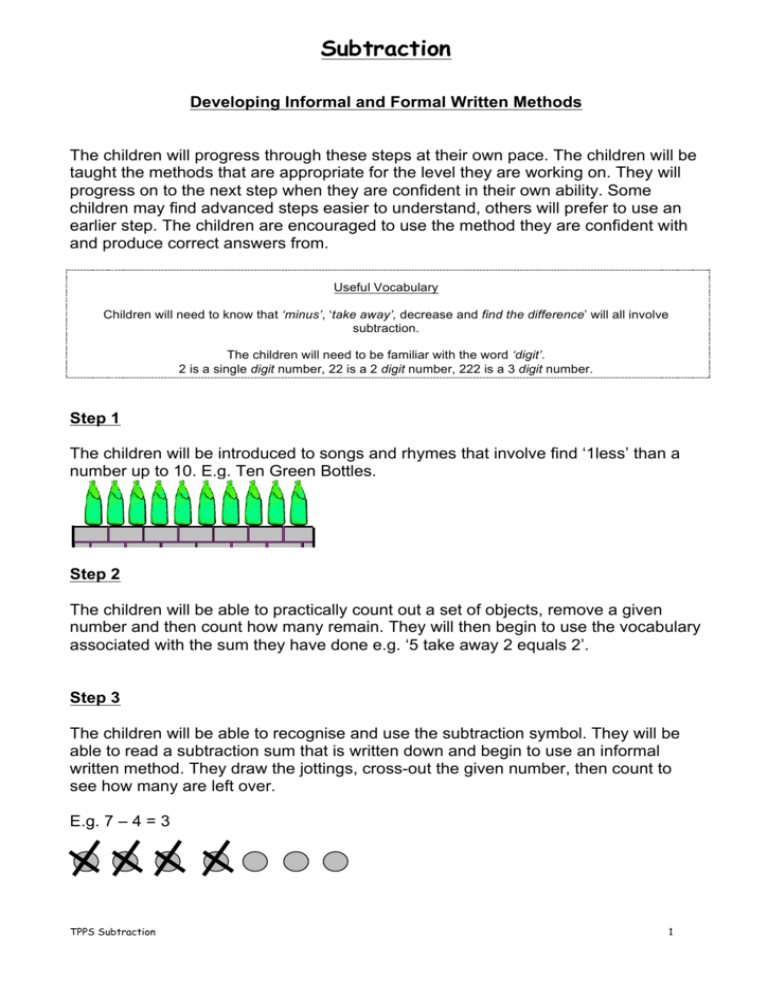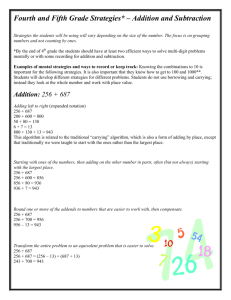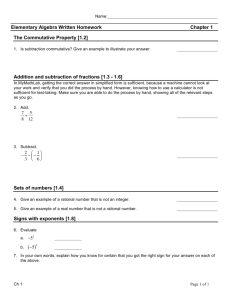Subtraction - Tickford Park
advertisement

Subtraction Developing Informal and Formal Written Methods The children will progress through these steps at their own pace. The children will be taught the methods that are appropriate for the level they are working on. They will progress on to the next step when they are confident in their own ability. Some children may find advanced steps easier to understand, others will prefer to use an earlier step. The children are encouraged to use the method they are confident with and produce correct answers from. Useful Vocabulary Children will need to know that ‘minus’, ‘take away’, decrease and find the difference’ will all involve subtraction. The children will need to be familiar with the word ‘digit’. 2 is a single digit number, 22 is a 2 digit number, 222 is a 3 digit number. Step 1 The children will be introduced to songs and rhymes that involve find ‘1less’ than a number up to 10. E.g. Ten Green Bottles. Step 2 The children will be able to practically count out a set of objects, remove a given number and then count how many remain. They will then begin to use the vocabulary associated with the sum they have done e.g. ‘5 take away 2 equals 2’. Step 3 The children will be able to recognise and use the subtraction symbol. They will be able to read a subtraction sum that is written down and begin to use an informal written method. They draw the jottings, cross-out the given number, then count to see how many are left over. E.g. 7 – 4 = 3 TPPS Subtraction 1 Step 4 Children should know subtraction facts to 10 by heart. They can use their fingers to help them learn these facts. E.g. 8 – 3 = 5 10 – 7 = 3 4–2=2 Step 5 Children should know subtraction facts to 20 by heart. E.g. 12 - 7 = 5 16 – 4 = 12 17- 14 = 3 Step 6 and 7 will be taught alongside each other so that children can see that ‘subtraction’ is the same as ‘finding the difference’. Step 6 Children will be able to use a completed number line and a pencil to subtract the smallest number from the largest number. They will start on the largest number and ‘jump’ back in steps of 1’s, 2’s and/or 10’s. E.g. 22 - 7 = 15 -1 12 13 14 15 -1 16 -1 17 -1 18 -1 19 -1 20 -1 21 22 23 E.g. 45 - 13 = 21 -1 31 32 - 10 -2 33 TPPS Subtraction 34 35 36 37 38 39 40 41 42 43 44 45 46 2 Step 7 Children will be able to use a completed number line and a pencil to find the difference between the smallest number and largest number. They will circle both numbers. Starting on the smallest number, they will count how many ‘jumps’ it takes to get to the largest number. This will then become their answer. E.g. 21 - 12 = 9 +1 12 +1 13 +1 14 +1 15 +1 16 +1 17 +1 18 +1 19 +1 20 21 22 23 Step 8 Children will be able to draw their own number line to subtract 2 and 3 digit numbers using the ‘find the difference’ method (Step 7). They will start by adding the units to the next multiple of 10. They will then add on multiples of 10 or 100, before finally adding on any remaining units (depending on what the calculation is). The answer is the total of how many ‘jumps’ have been made. Here the children will need to use their preferred method of addition. E.g. 72 – 54 = 18 +10 +6 54 +2 6 + 10 + 2 = 18 60 70 72 E.g. 812 - 264 = 548 +6 264 +30 270 +500 300 +10 800 +2 810 812 6 + 30 + 500 + 10 + 2 = 548 TPPS Subtraction 3 Step 9 This step is to set out the subtraction sum vertically, drawing on their knowledge of the method in Step 8. They will start on the smallest number and add on some units, rounding this number to the nearest multiple of 10. They will then add on multiples of 10 or 100, before finally adding on any remaining units (depending on what the calculation is). After each addition, the children will record the running total to the right of the calculation so that they remember the number they have calculated to. 401 - 125 5 70 200 + 1 276 (up to 130) (up to 200) (up to 400) (up to 401) Step 10 This final step is only for children who understand the place value and previous steps fully. This step is the ‘decomposition’ method. Decomposition method can cause a number of difficulties for children through lack of understanding e.g. ‘which digit do I cross out?’, particularly when there are 0’s in the larger number. Milton Keynes Numeracy Consultants have therefore recommended that schools teach this step only when they believe a child is fully competent with the process and understanding of subtraction. This method involves ‘borrowing’ an amount from a higher place value and moving it to a lower place value in the top number. E.g. 8042 – 387 E.g. 4035 – 1543 7 is unable to be subtracted from 2. Therefore, borrow ‘10’ from the 40, reducing this to 30. Now we can subtract 7 from 12 (5). Now that the 40 has reduced to 30, we are unable to subtract 80. Once again, we borrow from the larger place. As we are unable to borrow anything since there are 0 hundreds, we borrow from the thousands. Transfer 1000 to hundreds, then borrow 100 from here, leaving 900 remaining. We can now deduct our 80 from 130 (50), the 300 from 900 (600) and finally 0 from 7000 (7000). The answer to this calculation is 7655. J Now try these, using your chosen method: 1) 86 - 17 TPPS Subtraction 2) 126 - 74 3)1025 - 336 4) 7041 - 953 4




